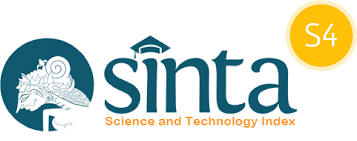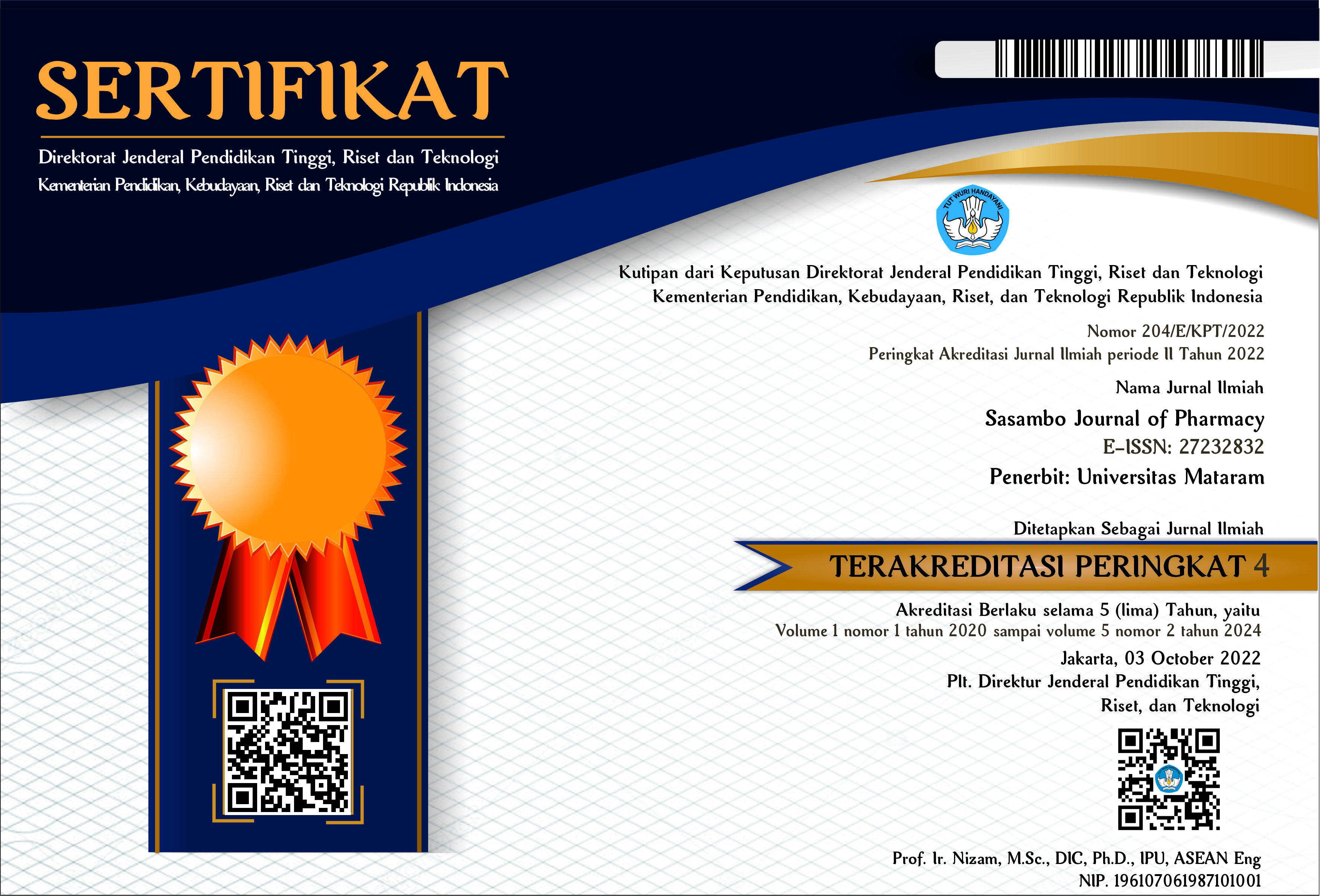Abstract
The ethnomedicinal study which conducted in East Lombok revealed 5 potentially plants that have wound healing properties (Jatropha multifida L., Stachytarpheta jamaicensis (L.) Vahl, Centella asiatica (L.) Urban, Euphorbia pulcherrima Willd, and Angelica keiskei). The five plants have been no further research related to the presence of compounds that have activity in wound healing. This study aims to screen the plants secondary metabolites from above plants. The sample was maserated with 96% solvent methanol. The viscous extract was determined by physical characterization including consistency and color as well as chemical characterization, namely the phytochemical screening test. The results showed that the five plants contained flavonoids, phenolics, saponins, and steroids, except for Stachytarpheta jamaicensis (L.) Vahl showed negative results for saponins and Angelica keiskei showed negative results for steroid compounds.
Â
Keywords: phytochemical screening, total phenolic content, wound healing herbs, East LombokKeywords:
total phenolic content, wound healing herbs, East LombokReferences
Agustina, D.R., Nurcahyanti, Lusiawati, D., dan Kris H. (2011). Aktivitas Antioksidan dan Antibakteri Ekstrak Polar dan Non Polar Biji Selasih, Jurnal Teknol dan Industri Pangan, 21(3), 1-6.
Apsari, Dwi, P., Susanti, H. (2011). Penetapan Kadar Fenolik Total Ekstrak Metanol Kelopak Bunga Rosella Merah (Hibiscus Sabdariffa Linn) dengan Variasi Tempat Tumbuh secara Spektrofotometri. Jurnal Ilmiah Kefarmasian, 2(1), 73-80.
Azwanida, N. N. (2015). A Review on the Extraction Methods Use in Medicinal Plants, Principle, Strength, and Limitation. Medical and Aromatic Plants, 4(3), 2-6.
Bruneton J. (1999). Pharmacognosy: Phytochemistry Medical Plants. 2n ed. Paris: Intercept Ltd, 297-301.
Staphylococus aureus dan Escherichia coli. Jurnal Kimia Mulawarman, 13(1), 35-9.
Hapsari, W. S., Rohmayanti, Yuliastuti, F., dan Pradani, M. P. K. (2017). Skrining Fitokimia Ekstrak Etanol Herba Pegagan dan Analisa Rendemen. Proceeding 6th University Research Colloquium, 6(1), 471-6.
Harliananda, N., Halimatussakdiah, dan Amna, U. (2019). Analisis Kualitatif Senyawa Metabolit Sekunder Daun Betadin (Jatropha multifida L.). Jurnal Kimia Sains dan Terapan, 1(1), 5-10.
Ibrahim, A. T., Sukenti, K., dan Wirasisya, D. G. (2019). Uji Potensi Antimikroba Ekstrak Metanol Daun Kastuba (Euphorbia pulcherrima Willd). Natural, 5(1), 13-8.
Kate, D. I. (2014). Penetapan Kandungan Fenolik Total dan Uji Aktivitas Antioksidan dengan Metode DPPH (1,1-Diphenyl-2-Pikrilhydrazil) Ekstrak Metanolik Umbi Bidara Upas (Merremia mammosa (Lour) Hallier f.). Skripsi, Yogyakarta: Fakultas Farmasi Universitas Sanata Dharma.
Kumala, S., Dyah, N., dan Bekti, P. (2016). Aktivitas Antibakteri dan Antioksidan Daun Pecut Kuda (Stachytarpheta jamaicensis L.) secara in Vitro. Jurnal Farmasi Indonesia, 8(2), 137–43.
Marliana, S. D., dan Saleh C. (2011). Uji Fitokimia dan Aktivitas Antibakteri Ekstrak kasar Etanol, Fraksi n-Heksana, Etil asetat, dan Metanol dari Buah Labu Air (Lagenari Siceraria (Morliana) Standl. Jurnal Kimia Mulawarman, 8(2), 39-63.
Maya, S. W., Citraningtyas, G., dan Lolo, W. A. (2015). Phytochemical Screening and Antipyretic Effect of Stem Juice from Kepok Banana (Musa paradisiaca L) on White Male Rats Stain Wistar (Rattus norvegicus) Induced with DTP-Hb. Pharmacon, 4(1), 1-11.
Nugrahani, R., Andayani, Y., dan Hakim, A. (2016). Skrining Fitokimia dari Ekstrak Buah Buncis (Phaseolus vulgaris L) dalam Sediaan Serbuk. Jurnal Penelitian Pendidikan IPA, 2(1), 96-103.
Robinson, T. (1995). Kandungan Organik Tumbuhan Tinggi. 6th ed (Terjemahan oleh Kosasih Padmawinata). K. Bandung: ITB.
Salmiwanti, Ilyas, A. dan Saleh, A. (2016). Isolasi Senyawa Metabolit Sekunder Fraksi N- Heksana dari Daun Pegagan (Centellaasiatica L.) dan Uji Antibakteri terhadap Mycobacterium tuberculosis. Al Kimia, 4(2), 52-63.
Sembiring, B. B. dan Feri M. (2011). Identifikasi Mutu Tanaman Ashitaba. Buletin Penelitian Tanaman Rempah dan Obat, 22(2), 177 – 185.
Sjamsuhidajat (2010). Buku Ajar Ilmu Bedah. Edisi ke-2. EGC. Jakarta.
Sopiah, B., Muliasari, H., dan Yuanita, E. (2019). Skrining Fitokimia dan Potensi Aktivitas Antioksidan Ekstrak Etanol Daun Hijau dan Daun
Chaithada, P., Supapan, J., Rodthuk, P., dan Chainarong, S. (2017). Total Flavonoids, Total Phenolic Content and Antioxidant Activity from Fruits, Leaves, Twigs and Flowers of Mesua Ferrea L. Walailak Journal Agricultural Technology and Biological Sciences. 15(4), 295-304.
Chun, O. K., Kim, D. O., and Lee, C. Y. (2003). Superoxide Radical Scavenging Activity of The Major Polyphenols in Fresh Plums. Journal of Agricultural and Food Chemistry, 51(27), 8067-72.
Departemen Kesehatan RI. (1978). Materia Medika Indonesia. Jilid ke-2. Departemen Kesehatan RI.
Departemen Kesehatan RI. (2000). Parameter Standar Umum Ekstrak Tumbuhan Obat. Departemen Kesehatan RI.
Dinas Kesehatan Provinsi NTB (2018). Profil Kesehatan Provinsi Nusa Tenggara Barat Tahun 2017. Dinas Kesehatan Provinsi NTB.
Febrina, L., Rolan R., dan Fairul M. (2015). Optimalisasi Ekstraksi dan Uji Metabolit Sekunder Tumbuhan Libo (Ficus Variegate Blume). Journal of Tropical Pharmacy and Chemistry, 3(2), 74-81.
Gonzalez, K. E., Colinas, M. T., Ramirez, D., Soto, R. M., dan Garcia, M. R. (2020). Antioxidant Properties in Bracts of Sun Poinsettia (Euphorbia pulcherrima) from Mexico. International Society for Horticultural Science, 1(1), 89-94.
Guo, S. dan L.A. DiPietro (2010). Factors Affecting Wound Healing. Journal of Dental Research, 89(3), 219-29.
Habibi, A. K. (2017). Skrining Fitokimia dan Aktivitas Antibakteri Ekstrak n-Heksan Korteks Batang Salam (Syzygium polyanthum). Skripsi, Semarang: Fakultas Sains dan Teknologi Universitas Islam Negeri Walisongo.
Haryati, Nur Aini, Chairul Saleh, Erwin. (2015). Uji Toksisitas dan Aktivitas Antibakteri Ekstrak Daun Merah (Syzygium mytifolium Walp) terhadap Bakteri
Merah Kastuba. Jurnal Ilmu Kefarmasian Indonesia, 17(1), 27.
Suhartati, R. dan Virgianti, D. P. (2015). Daya Hambat Ekstrak Etanol 70% Daun Ashitaba (Angelica keiskei) terhadap Bakteri Staphylococcus aureus yang Diisolasi dari Luka Diabetes. Jurnal Kesehatan Bakti Tunas Husada, 14(1), 162-72.
Suhirman, S. (2015). Skrining Fitokimia pada Beberapa Jenis Pecut Kuda (Stachytarpheta jamaicensis L. Vahl). Prosiding Seminar Nasional Swasembada Pangan, 1(1), 93-7.
Sumoza, N. S., Efrizal, dan Rahayu, R. (2014). Pengaruh Gambir (Uncaira gambir R.) terhadap Penyembuhan Luka Bakar Pada Mencit Putih (Mus musculus L.) Jantan. Jurnal Biologi Universitas Andalas, 3(4), 283-2.
Sutardi (2016). Kandungan Bahan Aktif Tanaman Pegagan dan Khasiatnya untuk Meningkatkan Sistem Imun Tubuh. Jurnal Litbang Pertanian, 35(3), 121-30.
Syarfati, K., Eriani, K., dan A. Damhoeri (2011). The Potential of Jarak Cina (Jatropha multifida L.) Secretion in Healing New-Wounded Mice. Jurnal Natural, 11(1), 39-44.
Tiwari, P., Kumar, B., Kaur, M., Kaur, G., dan Kaur, H. (2011). Phytochemical Screening and Extraction: A Review. Internationale Pharmaceutica Sciencia, 1(1), 98-106.
Tursiman, Puji, A. dan Risa, N. (2012). Total Fenol Fraksi Etil Asetat dari Buah Asam Kandis (Garcinia dioica Blume). Jurnal Kimia Khatulistiwa, 1(1), 45-8.
Wardana, A. P. dan Tukiran. (2016). Skrining Fitokimia dan Aktivitas Antioksidan Ekstrak Kloroform Tumbuhan Gowok (Syzygium polycephalum). Prosiding Seminar Nasional Kimia dan Pembelajarannya. Surabaya: Universitas Negeri Surabaya.
Watson, R., R. (2014). Polyphenols in Plants: Isolation, Purificaton and Extract Preparation. USA: Academic Press, 56.
License
Authors who publish with Sasambo Journal of Pharmacy (SJP), agree to the following terms:
- Authors retain copyright and grant the journal right of first publication with the work simultaneously licensed under a Lisensi Creative Commons Atribusi 4.0 Internasional. This license allows authors to use all articles, data sets, graphics and appendices in data mining applications, search engines, web sites, blogs, and other platforms by providing an appropriate reference. The journal allows the author(s) to hold the copyright without restrictions and will retain publishing rights without restrictions.
- Authors are able to enter into separate, additional contractual arrangements for the non-exclusive distribution of the journal's published version of the work (e.g., post it to an institutional repository or publish it in a book), with an acknowledgment of its initial publication in Sasambo Journal of Pharmacy
- Authors are permitted and encouraged to post their work online (e.g., in institutional repositories or on their website) prior to and during the submission process, as it can lead to productive exchanges, as well as earlier and greater citation of published work (See The Effect of Open Access).







